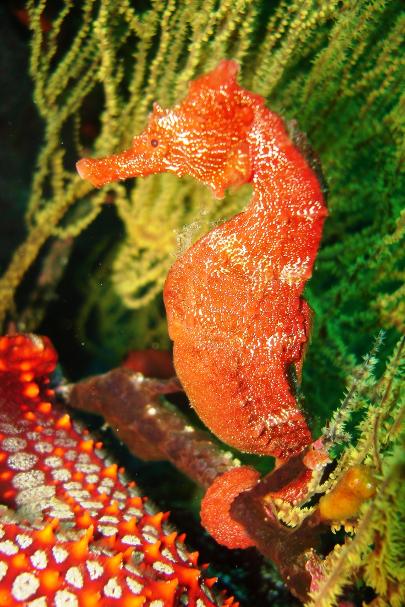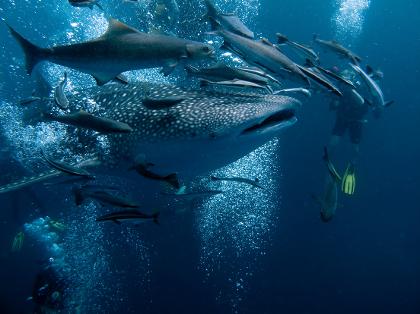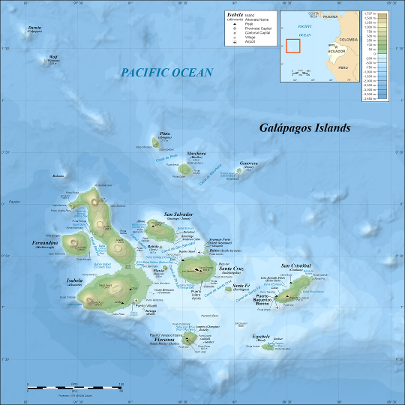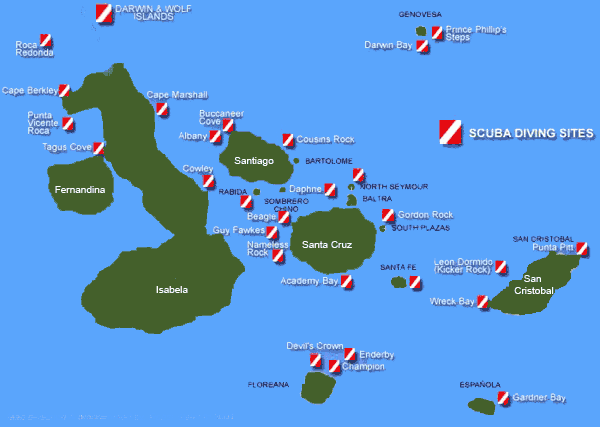
The “Enchanted Islands” of Galápagos are found in the Pacific Ocean, 926 kilometres west of Ecuador. 720 km to the North is Cocos Island and to the south is Easter Island and San Felix Island at 3,200 km. The Galápagos archipelago is composed of 13 main islands, 7 smaller islands, and many rocks and islets. The islands and their surrounding waters form an Ecuadorian province.
There are many wonders to discover in the Galápagos both above and below the water. Its geographical location at the confluence of three ocean currents makes the Galápagos one of the richest marine ecosystems in the world. Ongoing seismic and volcanic activity reflects the processes that formed the islands. These processes, together with the extreme isolation of the islands, has lead to the development of unusual and rare plant and animal life.
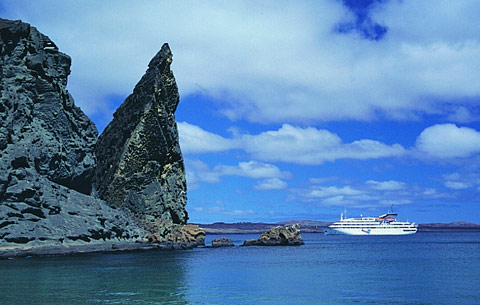
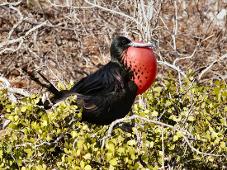
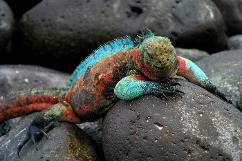
In 1959, 97.5% of the archipelago’s total surface (7,665,100 ha) was declared a National Park and in 1978, UNESCO designated Galápagos as the first World Heritage site. The Galápagos are home to some of the highest levels of endemism (species found nowhere else on earth) on the planet. About 80% of the land birds, 97% of the reptiles and land mammals, more than 30% of the plants and more than 20% of the marine species seen in Galápagos are endemic. Favorites include the giant Galapagos tortoise, marine iguana (the only lizard to swim in the ocean), flightless cormorant, red footed booby, and the Galapagos penguin — the only penguin species to be found in the Northern Hemisphere.
The indigenous animals are unusually tame due to lack of predation and many years of protection, making a visit to Galápagos such a memorable experience as you really will have up close encounters with the wildlife.
The Charles Darwin Foundation (CDF), an international non-governmental organisation (NGO) constituted in Belgium, whose core responsibility is to conduct research and provide research findings to the government for effective management of Galápagos, was also founded in 1959. The Charles Darwin Research Station was established on Santa Cruz Island in 1964. Originally the research station personnel conducted the conservation programmes to protect the native species but now much of the work is completed by the Galápagos National Park based on findings and methodologies developed by the CDF.
The islands are also surrounded by the Galápagos Marine Reserve which was created in 1986 (70,000 km2) and extended to its current area (133,000 km2) in 1998, making it one of the largest marine reserves in the world, second only in size to Australia’s Great Barrier Reef.
LINKS:
Marine Life ID Cards are available from the Galapagos Conservancy Shop: www.galapagos.org/shop
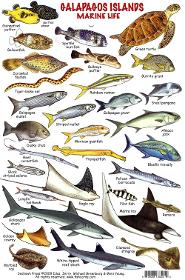
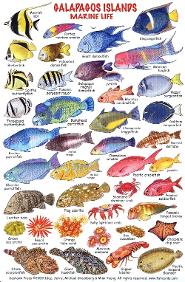
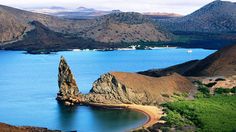
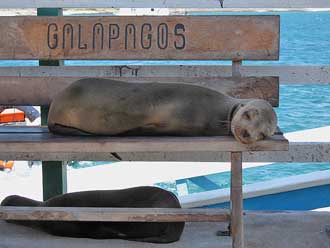
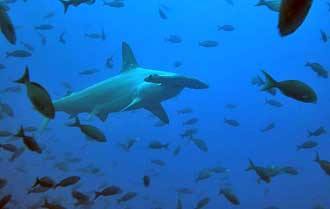
GEOGRAPHIC FEATURES
The Galápagos straddles the equator, with islands in the chain located in both the northern and southern hemispheres. Volcán Wolf (the highest point at 1,707m above sea level) and Volcán Ecuador on Isla Isabela are directly on the equator. Española Island, the southernmost islet of the archipelago, and Darwin Island, the northernmost islet, are spread out over a distance of 220 kilometres.
The largest islands are Isabela, measuring 5,827 km2 and making up almost three-quarters of the total land area of the Galápagos, Santa Cruz, Fernandina, Santiago and San Cristobal. Human settlements are restricted to zoned rural and urban areas on four islands only. A fifth island has an airport, tourism dock, fuel containment, and military facilities.
The archipelago is located on the Nazca Plate (a tectonic plate) and also sits atop the Galápagos hotspot where the Earth's crust is being melted from below by a mantle plume creating volcanoes. The first islands formed here at least 8 million and possibly up to 90 million years ago, the oldest islands having already disappeared below the sea, whilst the youngest islands, Isabela and Fernandina, are still being formed.
Most of the islands represent the summit of a volcano, some of which rise over 3,000 metres from the Pacific floor. The larger islands typically comprise of one or more gently sloping shield volcano, culminating in collapsed craters or calderas. Long stretches of shoreline are only slightly eroded. In many places faulting and marine erosion have produced steep cliffs and lava, coral or shell sand beaches. Other features include crater lakes, fumaroles, lava tubes, sulphur fields and a great variety of lava and other ejects such as pumice, ash and tuff.
SCUBA DIVING IN GALAPAGOS ISLANDS
The Galapagos Marine Reserve is an underwater wildlife spectacle. The sheer abundance of life is amazing. No other site in the world can offer the experience of diving with such a diversity of marine life forms that are so familiar with human beings that they accompany divers.
On any given dive you are likely to see sea lions, turtles, hammerhead sharks, white tip sharks, manta rays, Galapagos sharks and huge schools (sometimes between 50-100) of eagle and/or golden rays. There is also the possibility of seeing whales, whale sharks, thousands of dolphins and large schools of hammerheads, sometimes numbering in the hundreds. Between dives you can snorkel with penguins or walk right up to a 400 pound tortoise.
Darwin and Wolf Islands are probably two of the best dive sites in the world, and is where you’ll have the best chance to see whale sharks (in season) and schools of hammerheads. It takes approximately 15 - 20 hours of open ocean travel each way to reach them as they are located very far to the north (almost 200 km from the nearest island) and no land excursions are possible up there. These itineraries are not appropriate for non-divers as they will have very few land excursions available and will not visit as many of the islands as a trip which does not include Darwin and Wolf.
Divers visiting the Galapagos should have experience with cold water diving and diving in strong currents and surge. Visibility ranges from 10–25 metres and currents are medium to strong, ranging from 1 to 5 knots. Drift dives are common. Descending currents are often encountered and blue water safety stops are the norm requiring good buoyancy control. Surface conditions can be choppy.
Most divers are comfortable with a 7mm wetsuit from June to November with a hooded vest and gloves, and a 5 mm wetsuit from December to May. Gloves and hood are strongly recommended.
Darwin Island
The dives start near the famous Darwin Arch. Surface conditions and current can make diving here a challenge but you are likely to be distracted by the schooling hammerheads, spotted eagle rays, prowling Galapagos and silky sharks, an abundance of bigeye jacks, mackerels and turtles. Between June and October you may also encounter whale sharks. Warmer water species such as trumpetfish, trevally, barracuda, parrotfish, angelfish, surgeonfish and racoon butterflyfish can be found at Darwin Island. During your safety stop you may be joined by frolicking sea lions and dolphins.
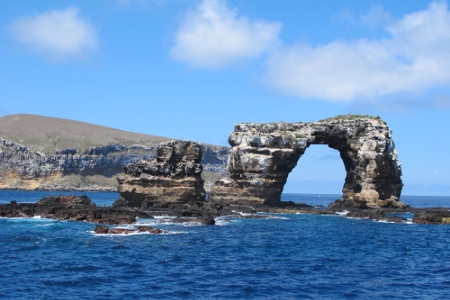
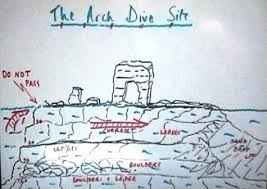
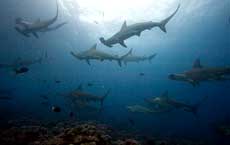
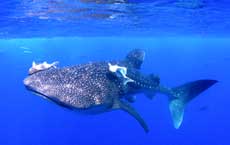
Wolf Island
Pods of bottlenose dolphins, playful sea lions, rays and turtles are often spotted from the dive boat before you even enter the water. Wolf Island has 3 distinct dive sites.
Landslide
Moray eels hide amongst the boulders and rubble that litter the seabed. However out in the blue is where the action is. See if you can spot the tuna, glasseye snapper, turtles, hammerheads and Galapagos sharks cruising in the distance, whilst the schools of eagle rays come in for a closer look.
The Cave
Apart from the abundant marine life, the underwater topography here makes this dive even more fascinating. There are a series of swim-throughs and a cave to explore. As you exit you may be greeted by hammerheads, white tip reef sharks, eagle rays and Galapagos sharks circling around you. At the end of the dive, drift amongst an engulfing melee of fish life before your safety stop.
Shark Bay
One of the best sites for diving with the inquisitive and playful Galapagos sea lions. As you plunge further down the rocky slope, keep an eye out for scalloped hammerheads in the blue. Galapagos and silky sharks in breathtaking numbers are also predominant here. Yellow fin tuna, pelican barracuda, the reflective African pompano and eagle rays are likely to come into view. In the shallows, a lone hammerhead may surprise you whilst you are watching the concentration of reef fish around you.

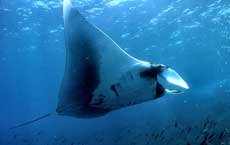
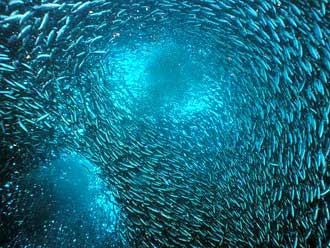
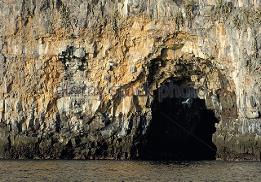
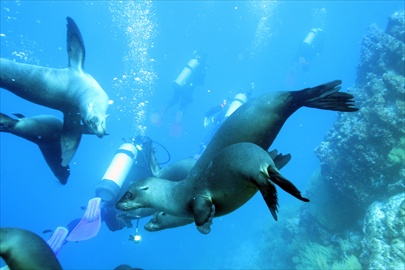
Punta Vincente Roca
Located on the northwest tip of the island of Isabela, the water temperature at this site can be quite chilly. Here you will see a diverse range of creatures different to other sites in the Galapagos including Mola Mola or Pacific Ocean Fish, Red Lipped Batfish scuttling across the ocean floor, seahorse, Galapagos penguins and the rare horn shark (Galapagos bullhead shark). There are plenty of ledges and crevices to explore in the reef wall. Keep an eye out for morays, spider crabs, slipper lobsters and cleaner shrimp. Above water you can see Flightless Cormorants, Blue Footed Boobies, Frigate Birds and Brown Pelicans.
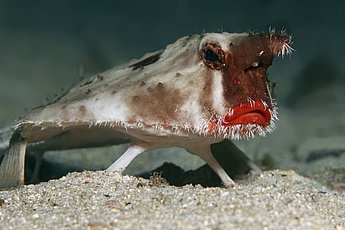
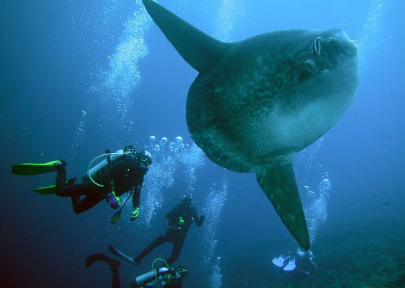


Cabo Marshall
Located off the northeast tip of Isabela island, this is where you should be on the look out for the graceful Giant Manta Rays. If the mantas choose not to put in an appearance you will still be entertained by white tip reef sharks, creole fish, barracuda, yellow fin tuna, grouper, snapper, turtles, fur seals and sea lions. Other rays to look out for are mobula rays and schools of cow-nose rays.
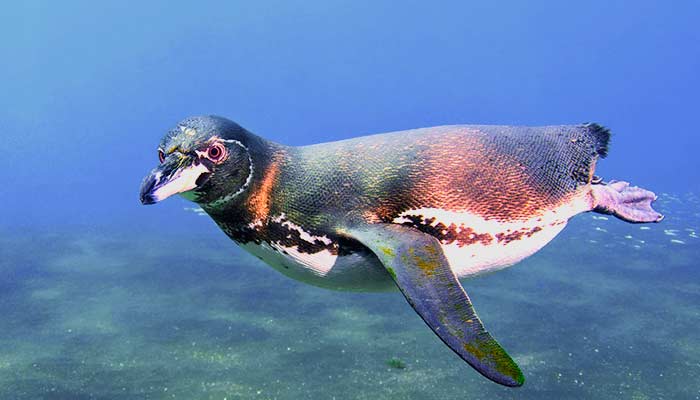
Cousin’s Rock
A favourite dive for the variety of things to see. This site is located off the east coast of Santiago (north of Bartolome Island). The volcanic rock is covered in black corals, small hard corals, sea fans and red sponges. Hiding amongst the coral and ledges/overhangs are Galapagos seahorse, octopus, frogfish, hawkfish and many nudibranchs. There are also opportunities to see plenty of bigger animals as well – Galapagos, hammerhead and reef sharks; mantas, marble rays and spotted eagle rays; schools of barracuda, green sea turtles, snappers and grouper. Watch the sea lions as they chase salema fish during your safety stop.
